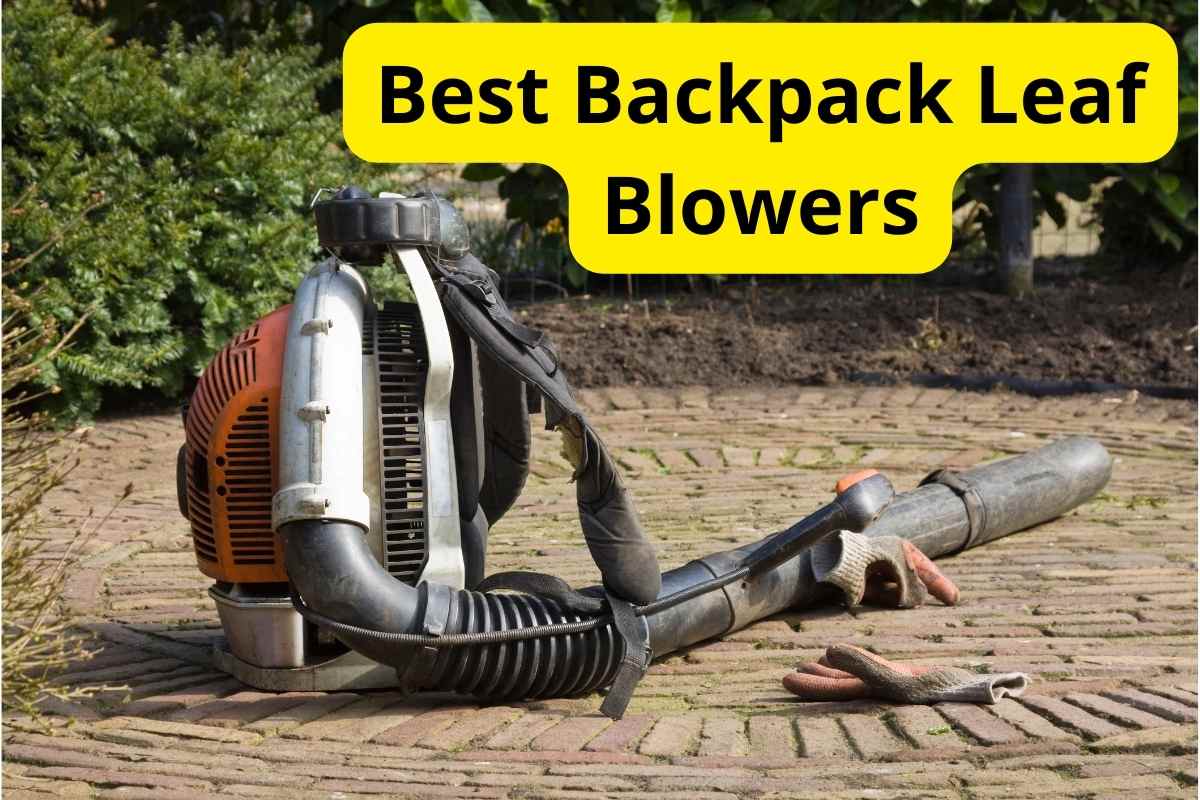
As leaves pile up on your lawn, the best backpack leaf blowers can save you time and backache. To help you choose the right tool for your fall cleanup, we scouted the top leaf blower retailers – Home Depot, Lowe’s, Amazon, and Walmart. We ranked each backpack leaf blower by performance, comfort, and cost to find the top 8 models.
Our leaf blower reviews help you find the best backpack blower for your yard by breaking down each model’s pros, cons, and specifications. We also included a buying guide that explains what each measurement means.
Our Top Picks
Top 5 Gas-Powered Backpack Leaf Blowers – Reviews
1. Schröder SR-6400L
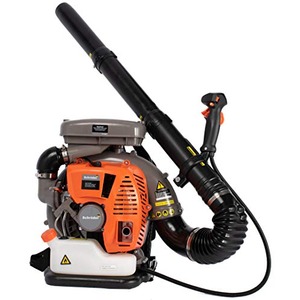
Schröder SR-6400L
When it comes to this Schröder industrial backpack leaf blower’s raw power, no other blower on this list comes close.
Homeowners with large yards and many trees will love the Schröder SR-6400L for its power, comfort, and durability. Top-notch German engineering combines with creativity to deliver the best gas-powered backpack leaf blower.
The SR-6400L quickly clears large piles of dry leaves, wet leaves, and pine needles and is one of the lightest high-performing backpack models. It also costs almost $100 less than the average backpack blower. With its lightweight design, padded shoulder straps, and back support, the SR-6400L won’t break your back or bank account.
Additionally, the SR-6400L is a versatile power tool that can be used for:
- Heavy-duty yard cleanup
- Gutter cleaning
- Dryer vent cleaning
- Snow removal
- Walkway cleanup
It features a potent 3.7 horsepower, 2-stroke engine and a compact yet sturdy body. It’s built to last, even when used for frequent heavy-duty cleanups, and Schröder backs its durability with a 5-year consumer warranty and 45-day money-back guarantee.
Specifications
- Airspeed: 230 MPH
- Air volume: 920 CFM
- Engine: 2-cycle, 63.3 cc, 3.7 HP
- Fuel tank capacity: 65 fl. oz.
- Noise level: 65 dB
- Warranty: 5 years
- Weight: 19.5 lb.
Pros and Cons
| What we liked | What we didn’t like |
| ✓ Clears a massive amount of debris at once ✓ Blows heavy debris ✓ Affordable ✓ Ergonomic ✓ Durable ✓ Quiet | ✗ Recoil starter is difficult to pull ✗ Not as many features as more expensive models |
2. Echo X Series PB-9010H
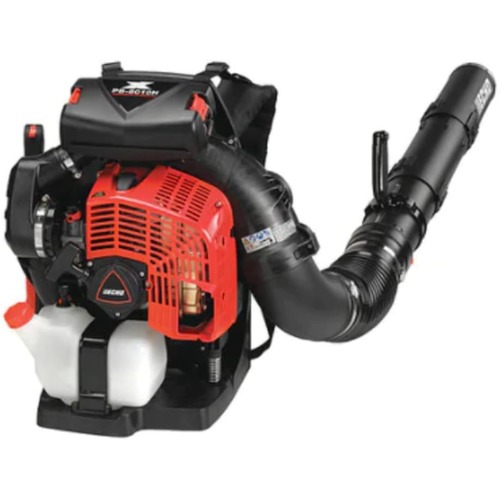
Echo X Series PB-9010H
Powerful 79.9cc Backpack Blower with 48 Newtons Performance, Dual Filters for Dusty Conditions, and Durable Metal Ring and Posi-Loc Connection.
We recommend the Echo X Series PB-9010H for homeowners willing to pay for high-performance, durability, and luxury features. Although it costs about twice as much as the Schröder SR-6400L, it’s more powerful and has way more features.
With 48 Newtons of blow force and a 79.9-cc professional-grade engine, the PB-9010H quickly clears large piles of leaves, grass clippings, and pine needles. It easily handles heavy-duty cleanup, including wet leaves, making it great for heavily wooded, large yards.
Its lavish list of luxuries includes:
- Durable Construction: Its Posi-loc pipes are secure and stable. It has a metal ring on its lower tube to reduce wear and help scrape debris. It also features a 2-stage air filtration system that protects the engine, even in rough conditions. And its 2-stroke professional-grade gas engine lasts years, even with heavy-duty use.
- Comfortable Design: The padded backpack is comfortable to carry, and the over-mold throttle handle reduces vibration. Additionally, the intake system blows cool air on the operator’s back, making warm-weather yard work much more comfortable.
- Variable Speed Control: It has variable speeds with cruise control, making the PB-9010H versatile. You can use it on lawns, landscaping, and paved surfaces.
- Tool-less Air Filter Access: You don’t need tools to clean or change the air filter.
- Large Gas Tank: With an 83.8-ounce fuel tank, you can finish large jobs without stopping to refuel.
If you spend a lot of time cleaning yard debris, the Echo PB-9010H is an excellent investment to reduce your time in the yard and increase your overall comfort.
Specifications
- Airspeed: 220 MPH
- Air volume: 1,110 CFM
- Engine: 2-cycle, 79.9 cc, professional grade
- Fuel tank capacity: 83.8 fl. oz.
- Noise level: 80 dB
- Warranty: 5 years
- Weight: 26.4 lb.
Pros and Cons
| What we liked | What we didn’t like |
| ✓ Clears a massive amount of debris at once ✓ Blows heavy debris ✓ Feature-packed ✓ Ergonomic ✓ Durable ✓ Versatile | ✗ Expensive ✗ No hip belt ✗ Loud |
3. Prorun PBB2884
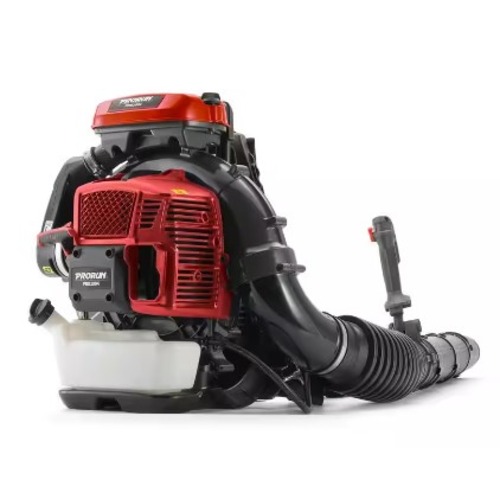
Prorun PBB2884
Power, Reliability, and Comfort in One. 1020 CFM, 240 MPH, 70-Minute Runtime. Backed by a 1-Year Warranty.
The Prorun PBB2884 is an average-priced backpack leaf blower with above-average performance. Its commercial-grade 4.2 horsepower engine delivers 42 Newtons of blow force, so clearing leaves is a breeze.
It’s loaded with the bells and whistles that you would only expect from high-end power equipment, such as:
- Adjustability: Its throttle grip handle, shoulder straps, and waist strap are all adjustable, making it great for homeowners who aren’t average-sized.
- Comfort: In addition to adjusting for comfort, it has an anti-vibration system and back padding.
- Speed: It has a variable speed throttle and easy-to-use cruise control settings.
- Convenience: You don’t need any tools to remove the air cover, and it gets up to 70 minutes of runtime on a full tank at full speed.
Additionally, the PBB2884 has a commercial-grade air filter and a spring-assisted pull handle. It’s an excellent option for homeowners who value comfort and performance, with some wiggle room in their budget but not enough for an expensive model.
Specifications
- Airspeed: 240 MPH
- Air volume: 1,020 CFM
- Engine: 2-cycle, 75.6 cc, 4.2 HP
- Fuel tank capacity: 56 oz.
- Noise level: 77 dB
- Warranty: 1 year
- Weight: 25.6 lb.
Pros and Cons
| What we liked | What we didn’t like |
| ✓ Clears a massive amount of debris at once ✓ Blows heavy debris ✓ Easy to start ✓ Adjustable for operators of atypical size | ✗ Not as durable as other blowers on our list ✗ Loud |
4. Husqvarna 150BT
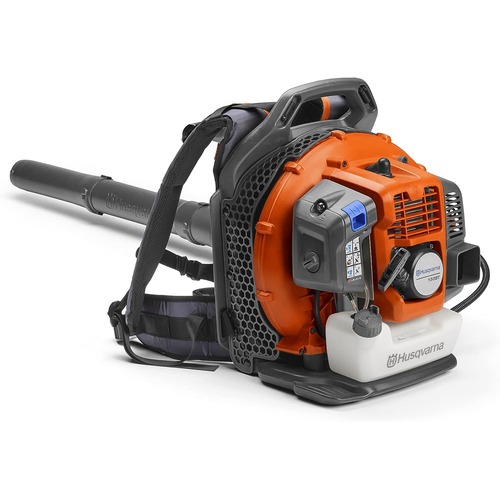
Husqvarna 150BT
The Husqvarna 150BT Gas Backpack Leaf Blower offers Powerful Clearing Performance with a 2-cycle engine, ergonomic design with a padded harness, and hassle-free operation.
Homeowners with heavy debris will love the Husqvarna 150BT’s impressive 270 MPH airspeed; it’s the fastest on our list. With 22 Newtons of blow force, it’s not as potent as the previous models, but its strength is nothing to sneeze at. Clearing leaves, pine needles, and hedge trimmings won’t take much time unless you have a heavily wooded yard over an acre.
And if you’re looking for gas-powered potency but want to reduce your carbon footprint, the 150BT is your top choice. Its 2.16 horsepower X-torq engine has excellent fuel efficiency and reduces emissions by up to 60%.
It also includes the following features:
- Ergonomic Harness: It’s thickly padded with a hip belt to distribute weight evenly and reduce fatigue.
- Air Purge: Air is removed from the carburetor and fuel system to make starting easier.
- Variable Speed: It has a variable speed throttle with cruise control for versatility and ease of use.
It’s simple to see why the 150BT is Husqvarna’s best-selling backpack blower. With all its power and perks, it costs less than the average gas-powered backpack blower. And you can use Husqvarna’s premixed fuel for convenience and to increase the tool’s warranty to 5 years.
Specifications
- Airspeed: 270 MPH
- Air volume: 765 CFM
- Engine: 2-cycle, 51 cc, 2.16 HP
- Fuel tank capacity: 42.24 oz.
- Noise level: 94 dB
- Warranty: 2 years
- Weight: 22.5 lb.
Pros and Cons
| What we liked | What we didn’t like |
| ✓ Blows heavy debris ✓ Clears a lot of debris at once ✓ Ergonomic ✓ Fuel-efficient ✓ Durable ✓ Affordable | ✗Very loud; ear protection is an absolute must ✗Not as potent as other gas models on our list |
5. Shindaiwa EB910RT
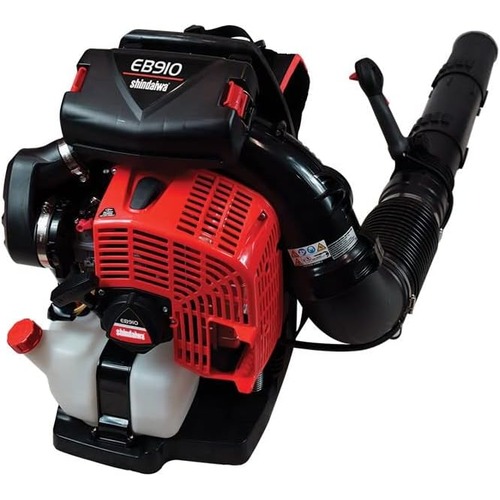
Shindaiwa EB910RT
Unleash the Power of 79.9cc Engine and 48 Newtons. Built for Comfort and Durability with Padded Backpack and Improved Design. Backed by a 2-Year Commercial and 5-Year Consumer Warranty.
With a 79.9-cc 2-cycle engine and 48 Newtons of blow force, the Shindaiwa EB910RT is a leaf-blowing powerhouse. It lets the operator quickly clear large amounts of debris while staying comfortable, so it’s great for homeowners with heavily wooded yards over an acre. However, it’s also our list’s most expensive gas blower, costing a bit more than the Echo PB-9010H.
Its laundry list of lavish features includes:
- Two-stage Air Filtration: Its large, top-mounted air filter and foam pre-filter keep the engine clean and are accessible without tools.
- Ergonomic Design: It has heavy padding, non-separating strap connections, and an over-mold handle, and its intake system blows cool air on the operator’s back.
- Sturdy Construction: Its 91 mm Posi-loc pipe connections are sturdy and secure, and its carbon fiber frame is lightweight yet durable. It also has a metal ring on the blower tube for increased durability.
- Variable Speeds: It has adjustable speeds with cruise control to handle a variety of cleanup tasks.
The EB910RT also features anti-vibration technology, a long tube, and a large translucent fuel tank. Although it may be overkill for many homeowners, those with frequent heavy-duty clean-ups will appreciate its speed, comfort, and control.
Specifications
- Airspeed: 220 MPH
- Air volume: 1,110 CFM
- Engine: 2-cycle, 79.9 cc
- Fuel tank capacity: 83.8 oz.
- Noise level: 80 dB
- Warranty: 5 years
- Weight: 26.7 lb.
Pros and Cons
| What we liked | What we didn’t like |
| ✓ Clears a massive amount of debris at once ✓ Blows heavy debris ✓ Ergonomic ✓ Durable ✓ Feature-packed | ✗ Expensive ✗ Loud |
Top 3 Battery-Powered Backpack Leaf Blowers – Reviews
1. Ego Power+ LBPX8004-2
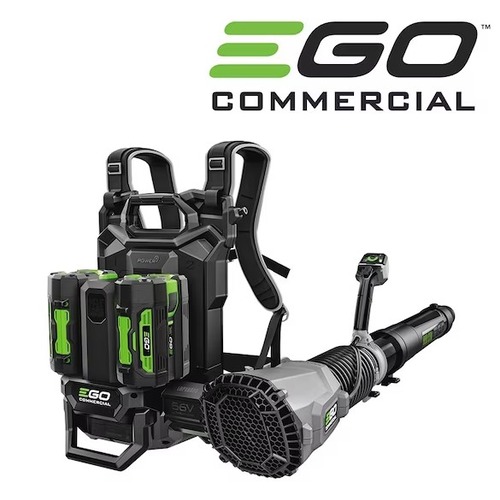
Ego Power+ LBPX8004-2
EGO Commercial 800 CFM Backpack Blower: Cordless Power and Durability. Equipped with 1,900W Brushless Motor, 800 CFM, and 120-Minute Runtime. The Future of Professional Blowers.
The best electric backpack leaf blower on our list is the Ego Power+ LBPX8004-2. Ego uses industry-leading lithium-ion technology to deliver a commercial-grade device with 26 Newtons of blow force. It’s durable and efficient, with up to 120 minutes of runtime on low and 25 minutes on turbo.
Eco-minded homeowners sick of mixing gas with oil will love the tool’s gas-competing potency; it has as much power as a 60-cc gas engine. It has a high-efficiency brushless motor, an ergonomic design, and wind speeds up to 190 MPH. As a result, you can comfortably clear large amounts of wet leaves, dry leaves, and pine needles in no time.
It’s also packed with state-of-the-art features, including:
- Variable Speeds: You can adjust the blower’s speed to fit the job, making it great for handling debris on your lawn, landscaping, walkways, and driveway. It also includes 2 blower tubes, increasing the tool’s versatility.
- EGO Power+ Dual-Port Charger: The included charger charges both 56-volt ARC Lithium batteries in 90 mins.
- Heavy-Duty Construction: It has IPX5-rated weather-resistant construction and extra-sturdy straps and padding.
- Digital Controls: Its digital control system makes it quick and easy to adjust settings while you work.
- Comfortable Design: Although it’s heavier than most gas models, the weight is well-balanced and offset by comfort features. It has dual grip handles, sturdy straps, and a back pad. Additionally, its hand grip, harness, and tube are adjustable, making it comfortable for various-sized operators.
However, all its perks come at a cost. The LBPX8004-2 is the most expensive blower on our list. But keep in mind that you won’t have to spend as much on maintenance as you do with a gas blower.
Specifications
- Airspeed: 190 MPH
- Air volume: 800 CFM
- Battery: 56-volt, 6 Ah ARC Lithium
- Max runtime: 120 min.
- Motor: Brushless
- Noise level: 65 dB
- Warranty: 5 year tool, 3 year battery
- Weight: 29 lb.
| Battery included? | Yes (2) |
| Charger included? | Yes |
Pros and Cons
| What we liked | What we didn’t like |
| ✓ Blows heavy debris ✓ Clears a lot of debris at once ✓ Ergonomic ✓ Easy to use ✓ Eco-friendy ✓ Durable ✓ Quiet | ✗ Expensive ✗ Heavy |
2. Ryobi RY404170
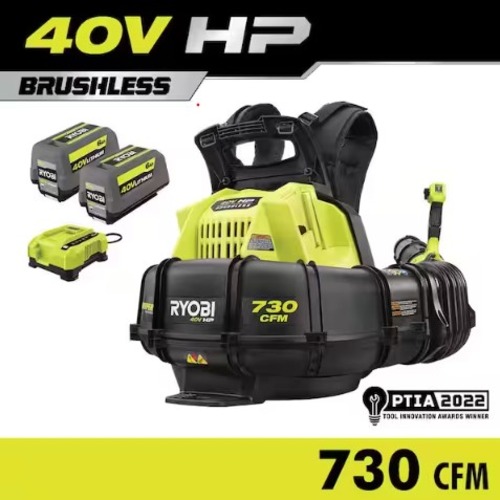
Ryobi RY404170
Quiet, Powerful, and Efficient: The 40V HP WHISPER SERIES Backpack Blower. 730 CFM, 165 MPH, 85% Quieter Than Gas. Kit with (2) 40V 6.0 Ah Batteries and Rapid Charger. 5-Year Tool Warranty.
The Ryobi 40V Whisper Series Backpack Blower is robust and low-noise. At just 59 decibels, it’s the quietest backpack blower we found. Yet it’s packed with more power than a 51-cc gas engine, so it blows a lot of debris at once. Its brushless motor and 40-volt batteries get up to 52 minutes of runtime on low and 40 minutes on mid-speed.
Ryobi filled the RY404170 with fabulous frills, including:
- Comfort Features: Although heavier than most backpack blowers, the weight is well-supported with comfort-enhancing features, including a contoured back and adjustable straps.
- Variable Speed: It has a variable speed trigger, a turbo button, and cruise control. It also comes with a speed tip attachment for maximum airspeed.
- Rapid Charger: The included charger fully charges the battery in less than an hour.
Although its airspeed is slower than the previous models on our list, it’s still strong enough to manage heavier debris such as wet leaves. Ryobi loaded a lot of value into an average-priced backpack blower that’s eco-friendly and easy to operate.
Specifications
- Airspeed: 165 MPH
- Air volume: 730 CFM
- Battery: 40-volt, 6 Ah Li-ion
- Max runtime: 53 min.
- Motor: Brushless
- Noise level: 59 dB
- Warranty: 5 year tool, 3 year battery
- Weight: 30 lb.
| Battery included? | Yes (2) |
| Charger included? | Yes |
Pros and Cons
| What we liked | What we didn’t like |
| ✓ Clears a lot of debris at once ✓ Extra quiet, even for an electric tool ✓ Eco-friendly ✓ Easy to use ✓ Comfort-enhancing features | ✗ Slower airspeed than most backpack models ✗ Heavy |
3. Worx Nitro WG572
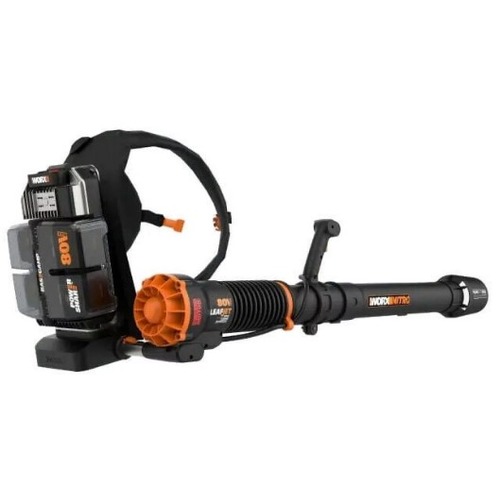
Worx Nitro WG572
Unleash the Power of 80 Volts. 800 CFM, Long-Lasting Brushless Motor, and Convenient Base Camp Charger. The Ultimate Blower for Your Yard and Commercial Needs.
The WORX Nitro WG572 cordless electric leaf blower is one of the best battery-powered models. Its brushless motor runs on four 20-volt lithium-ion batteries for 80 volts of power and up to 230 minutes of runtime. However, it’s compact and, with all its batteries, only weighs 23.6 pounds, making it the lightest electric model on our list.
Additionally, the WG572 is loaded with the following advantageous amenities:
- Dual Air Intake: It pulls in additional air and has a sonic turbine fan to reach air volumes of up to 800 CFM. With 22 Newtons of blow force, it’s more potent than many gas models and competitive with top-tier gas blowers such as the Husqvarna 150BT.
- Variable Speeds: It has an adjustable speed setting, turbo mode, and cruise control.
- Base Camp: It runs on Worx’s portable and transferable power pack system that holds four 20-volt batteries. It’s compatible with other Worx tools, and the 4-port charger charges all four batteries at the same time. The total charge time is about 4 to 5 hours.
- Comfort Features: In addition to its lightweight design, the WG572 has adjustable padded shoulder straps and chest and waist straps.
Although it has the slowest airspeed on our list, 150 MPH isn’t child’s play. The WG572 is an eco-friendly, high-performance tool with superb runtime, making it an excellent choice for homeowners who spend a lot of time cleaning their yards in the fall. It clears large amounts of debris in a single pass and has enough runtime to complete most yards on a single charge.
Specifications
- Airspeed: 150 MPH
- Air volume: 800 CFM
- Battery: 20-volt, 4 Ah Li-ion
- Max runtime: 230 min.
- Motor: Brushless
- Noise level: 83 dB
- Warranty: 5-year tool, 3-year battery
- Weight: 23.6 lb.
| Battery included? | Yes (4) |
| Charger included? | Yes |
Pros and Cons
| What we liked | What we didn’t like |
| ✓ Clears a lot of debris at once ✓ Easy to use ✓ Long runtime ✓ Lightweight for an electric model | ✗Slower airspeed than most backpack models ✗ Expensive |
Buyer’s Guide
We’ve just shown you our top 8 picks and what makes each leaf blower a winner. The next step is figuring out which backpack leaf blower meets your needs.
Let’s review the basics:
Yard and Project Size
First, consider how demanding your project is and your yard’s size:
- Small Yards: If you have a small yard that only receives a few dry leaves every autumn, we recommend a leaf blower that doesn’t blast you over the moon. Consider a handheld blower from our best leaf blower list. Many homeowners with small yards choose one of the best electric leaf blowers because corded models are typically the least expensive.
- Large Yards: If you have a large yard, you’ll want a leaf blower with a high air volume (CFM) to get more done with less effort. It’s also important to consider comfort and runtime because large yards require longer periods of work. All of the backpack blowers on our list are suitable for large yards.
- Commercial: If you need a commercial-grade leaf blower to tackle those heavy-duty projects, call your local lawn care company or opt for a leaf blower with a strong blow force and durable design. Ensure you can safely operate a high-performing leaf blower before you strap it to your back.
Need assistance operating a professional-grade gas backpack leaf blower? Check out how to safely operate one here:
Power Source
Our list includes both battery- and gas-powered backpack leaf blowers. Both leaf blower types have their advantages and disadvantages.
Gas Leaf Blowers
The advantages of gas leaf blowers include:
- Performance: On average, they reach higher CFMs and MPHs than battery-powered leaf blowers, and the most potent backpack models run on gas.
- Runtime: Typically, gas models have longer runtimes than battery models, and it takes less time to refill a gas tank than it takes to charge a battery
- Weight: On average, gas blowers weigh less than battery models because gas weighs less than batteries.
The disadvantages of gas leaf blowers include:
- Maintenance: They’re high maintenance and require oil changes, air filter cleaning, and more every year.
- Emission: They emit exhaust fumes that are unhealthy for the user and the environment.
- Noise level: They tend to be louder than battery leaf blowers. Some communities have rules about how loud power tools can be, so check with your local municipality or HOA before purchasing a large gas leaf blower.
Battery Leaf Blowers
The advantages of battery leaf blowers include:
- Eco-friendly: They don’t emit harmful exhaust fumes
- Less noisy: Battery-powered models tend to be quieter than gas models.
- Low-maintenance: They don’t require any engine maintenance, as gas power tools do.
The disadvantages of battery leaf blowers include:
- Runtime: Battery blowers tend to have shorter runtimes, and batteries can take a while to recharge.
- Performance: Many are just as powerful as gas models, but the best gas leaf blowers outperform the best battery-powered blowers.
Blow Force
When it comes to your leaf blower’s performance, the two most important specs are airspeed (MPH) and air volume (CFM):
- MPH: MPH stands for miles per hour, and it measures airspeed. MPH states the rate at which air passes through the nozzle. Blowers with higher airspeeds can push heavier debris, such as wet leaves and pine needles.
- CFM: CFM stands for cubic feet per minute and measures air volume. It tells you how much air passes through the nozzle per minute. The higher the CFM, the more debris a blower can manage in one pass.
Some manufacturers also release their blower’s total blower force, measured in Newtons (N). Blow force combines CFM and MPH into one comprehensive measurement.
The table below shows the typical maximum CFM and MPH for all backpack leaf blowers.
| CFM | MPH | |
| Average | 700 | 200 |
| Typical Range | 550 – 870 | 170 – 230 |
| Extreme Low | 375 | 145 |
| Extreme High | 1,110 | 270 |
Comfort
If you’re looking at backpack blowers, you probably have a lot of leaves to manage. A comfortable blower will save you time and stress.
Consider buying a backpack leaf blower with:
- Padded shoulder straps
- Adjustable straps
- Contoured back
- Over-mold handle
- Anti-vibration design
Lightweight designs are also more comfortable to carry, and the table below shows the typical weight of all backpack leaf blowers.
| Average Weight | 24 pounds |
| Typical Range | 20 – 28 pounds |
| Extreme Low | 12 pounds |
| Extreme High | 56 pounds |
Noise Level
Before buying your leaf blower, check its decibel (dB) rating and local policies. Several cities, counties, and HOAs have ordinances to limit noise pollution. Some areas restrict maximum noise levels, and others determine what time of day you can use noisy power tools. The strictest districts ban gas leaf blowers entirely.
The table below shows typical noise levels for all backpack leaf blowers.
| Average Noise Level | 76 dB |
| Typical Range | 65 – 88 dB |
| Extreme Low | 59 dB |
| Extreme High | 100 dB |
However, battery-powered backpack leaf blowers tend to be quieter than gas-powered models.
| Average Gas Backpack Blower Noise Level | 79 dB |
| Average Battery Backpack Blower Noise Level | 70 dB |
Hearing protection: You should always use hearing protection with power tools that are 85 dB or louder. In addition to being loud, the leaf blower sound is particularly annoying, so some organizations recommend hearing protection for blowers that are 65 dB or louder.
Price
Although the average leaf blower costs about $149, backpack blowers are more expensive, as shown in the table below.
| Average Backpack Blower | $430 |
| Typical Range | $320 – $540 |
| Extreme Low | $230 |
| Extreme High | $700 |
The average gas-powered backpack blower costs slightly less than the average battery-powered backpack blower.
| Average Gas Backpack Blower | $420 |
| Average Battery Backpack Blower | $450 |
But the price difference increases with high-performance backpack models.
| Average Cost of Best Gas Backpack Blowers | $475 |
| Average Cost of Best Battery Backpack Blowers | $570 |
FAQ About Backpack Leaf Blowers
1. Which is more important, MPH or CFM?
Both numbers are significant, but don’t let one high value fool you.
A 250 MPH leaf blower may sound impressive. After all, if the air is traveling out of the nozzle at 250 miles per hour, then the leaf blower must be robust, right? But if the CFM is only at 300, the airflow might not be strong enough to move heavy piles of wet leaves.
You’ll find that a leaf blower with a 230 MPH coupled with a 700 to 900 CFM will perform much better than the 250 MPH leaf blower with only a 300 CFM.
2. What is the most reliable leaf blower brand?
The most reliable leaf blower brands include:
- Schröder
- Echo
- Husqvarna
- Ego
3. How much does leaf removal cost?
For an average-sized residential lawn (1/4 acre), expect hiring a lawn care service for leaf removal to cost $100 – $200. Although prices vary by yard size and location, the national average price range is $165 – $485.
4. Can you use leaf blowers for snow removal?
If there is less than an inch of snow, gas-powered leaf blowers with at least 400 CFM and 150 MPH effectively melt it away. However, consider one of the best snow blowers if you have over an inch of snow.
When to Call a Leaf Removal Pro
After considering the upfront cost of a backpack leaf blower, operating and maintenance costs, and time spent in the yard, most homeowners decided it’s better to hire a pro. Thankfully, LawnStarter can connect you with affordable local leaf removal crews who are qualified and insured. Quotes are free and available online. So, check out our pros’ prices before buying a blower.
In addition to yard cleanups, our network of pros handles over 30 outdoor home services, including routine lawn care, bush trimming, and gutter cleaning. In most cases, you don’t even have to be home when your pros arrive. Our user-friendly app and customer-centric support team seamlessly handle everything. So, you can just sit back and enjoy your pristine yard!
LawnStarter participates in the Amazon Services LLC Associates Program and other retailer affiliate programs. LawnStarter may earn revenue from products promoted in this article.
Main Image Credit: ElsvanderGun / Canva Pro / License wih Text Overlay using Canva Pro
![10 Best Cordless Leaf Blowers of 2025 [Reviews] worker cleaning leaves with a blower with text overlay on it](https://www.lawnstarter.com/blog/wp-content/uploads/2021/07/Best-Cordless-Leaf-Blowers.jpg)
![10 Best Electric Leaf Blowers of 2025 [Reviews] gardener with cordless leaf blower with text overlay on it](https://www.lawnstarter.com/blog/wp-content/uploads/2023/11/Best-Electric-Leaf-Blowers.jpg)
![10 Best Gas Leaf Blowers of 2025 [Reviews] worker cleaning leaves with a blower with text overlay on it](https://www.lawnstarter.com/blog/wp-content/uploads/2023/10/Best-Gas-Leaf-Blowers.jpg)
![9 Best Leaf Blowers of 2025 [Reviews] leaf blower cleaning leaves on floor with text overlay on it](https://www.lawnstarter.com/blog/wp-content/uploads/2023/11/Best-Leaf-Blowers.jpg)
![10 Best Backpack Weed Sprayers of 2025 [Reviews] gardener spraying weed killer on lawn with text overlay on it with text overlay on it](https://www.lawnstarter.com/blog/wp-content/uploads/2021/12/Best-Backpack-weed-sprayers.jpg)